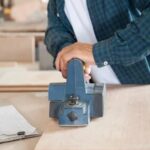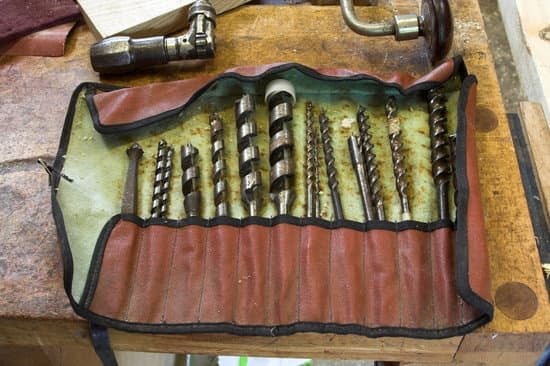Electric Plane Woodworking is a fascinating and versatile craft that combines the precision of woodworking with the efficiency of electric power. Whether you are a beginner or an experienced woodworker, understanding the basics of electric plane woodworking is essential to achieving quality results and honing your skills.
In this article, we will explore everything you need to know about this technique, from what an electric plane is and how it works to the advantages it offers in terms of efficiency and precision.
At its core, an electric plane is a powerful tool designed specifically for woodworking tasks. It functions by removing thin layers of wood in a smooth and controlled manner, allowing for precise shaping, leveling, and smoothing of surfaces.
Unlike traditional hand planes that require physical exertion, electric planes rely on electrical power to drive their blades with speed and consistency. This makes them a valuable tool for both amateur woodworkers looking to enhance their projects and professional craftsmen seeking efficiency in their work.
One of the key advantages of electric plane woodworking is its efficiency. With its motor-driven blades, an electric plane can swiftly remove material from large surfaces or tackle intricate details with ease. This saves valuable time compared to manual planing methods while still achieving precise results. Additionally, the consistent speed provided by an electric plane ensures evenness in thickness throughout the wood, eliminating potential inconsistencies that can arise from human error.
In addition to its efficiency, electric plane woodworking also offers unparalleled precision. The ability to adjust blade depth allows for fine-tuning cuts according to specific project requirements. Whether it’s creating clean, straight edges or achieving intricate profiles, an electric plane excels at delivering accurate results consistently. This precision opens up a world of possibilities for woodworkers who want to push their creativity beyond traditional techniques.
As we delve deeper into Electric Plane Woodworking in the following sections, we will explore various aspects such as choosing the right electric plane for your needs, safety tips and precautions when working with these tools, step-by-step guides on mastering techniques, common mistakes to avoid, and advanced techniques for more creative applications.
By the end of this article, you will not only have a thorough understanding of electric plane woodworking but also be equipped with the knowledge and skills to embrace the power and artistry it offers.
Understanding the Basics
An electric plane is a power tool used in woodworking that is designed to remove material from a wooden surface. It operates using an electric motor, which powers a rotating blade or cutterhead. The blade spins rapidly, allowing it to shave off thin layers of wood with each pass. This process creates smooth and flat surfaces on the wood, making it an essential tool for various woodworking projects.
The design of an electric plane typically consists of a housing that contains the motor and a handle for the user to grip. There is also a set of blades or cutterheads that are positioned at the front of the housing. These blades can be adjusted and locked into different depths depending on the desired thickness of wood being removed.
To operate an electric plane, you simply turn it on and glide it over the wooden surface. As you move the tool forward, the blades or cutterhead will slice through the wood, shaving off thin layers as it goes. The plane should be used with steady and even pressure to ensure consistent results. Some electric planes also have features such as depth adjustment settings and dust collection systems to enhance ease-of-use and efficiency.
One important thing to note is that different types of blades or cutterheads can be used with electric planes, depending on the specific task at hand. For example, straight blades are commonly used for smoothing large areas quickly, while spiral or helical cutterheads are more suitable for creating unique textures or patterns on the wood surface.
In summary, an electric plane is a versatile power tool that helps woodworkers achieve smooth and flat surfaces on their projects. By understanding its basic components and operation, you can begin harnessing its power in your own woodworking endeavors.
The Advantages of Electric Plane Woodworking
Electric plane woodworking offers numerous advantages, particularly in terms of efficiency and precision. Whether you are a professional woodworker or a DIY enthusiast, understanding these benefits can help you make the most of electric plane tools and achieve exceptional results.
Increased Efficiency
One of the primary advantages of electric plane woodworking is the significant increase in efficiency it provides. Unlike traditional hand planes, electric planes are powered by electricity or rechargeable batteries, which eliminates the need to exert physical force during planing. This not only speeds up the overall process but also reduces fatigue, allowing you to work for longer periods without strain.
Additionally, electric planes typically have adjustable cutting depths and features like depth stops, making it easier to remove specific amounts of material accurately and efficiently. With a traditional hand plane, achieving consistent results can often be time-consuming and require significant skill. Electric planes streamline this process and enable woodworkers with different skill levels to achieve professional-looking results in less time.
Enhanced Precision
Precision is another crucial aspect where electric plane woodworking truly shines. These tools are designed with advanced features that improve accuracy and allow for fine-tuning adjustments. Many models include depth adjustment knobs or levers that offer precise control over the amount of material being removed.
Additionally, electric planes often feature built-in dust extraction systems or attachments that effectively collect wood shavings as you work. This not only keeps your workspace cleaner but also allows you to maintain better visibility of your project, ensuring precise measurements and cuts.
Furthermore, some electric planes come equipped with additional features like chamfering guides or fence systems that assist in creating specific angles or straight edges with utmost precision. These accessories greatly contribute to the overall accuracy when working on woodworking projects.
Choosing the Right Electric Plane
When it comes to choosing an electric plane for woodworking, there are several key features that you should consider. These features will not only affect the performance and efficiency of your woodworking projects but also ensure that you get the best value for your money. Here are some key features to look for when selecting an electric plane.
- Power and Speed: The power and speed of an electric plane are crucial factors to consider. A higher power rating will allow you to work on harder types of wood and tackle more demanding projects. Additionally, a variable speed control feature will give you more control over the cutting depth and allow for more precise finishes.
- Blade Size and Type: The size and type of blade in an electric plane determine its cutting capacity and versatility. Smaller blades are ideal for delicate work, while larger blades can handle tougher materials. It’s also important to consider the availability of replacement blades and their cost.
- Ergonomics: Since woodworking can require long hours of use, choosing an electric plane with good ergonomics is essential. Look for a model with a comfortable grip, well-balanced weight distribution, and easy-to-reach controls. This will minimize fatigue and enhance your overall experience when using the electric plane.
- Dust Collection System: Woodworking produces a significant amount of sawdust, which can be messy and hazardous if not properly controlled. Opting for an electric plane with a built-in dust collection system or compatibility with external dust extractors will help keep your work area clean and reduce health risks.
- Durability and Build Quality: Investing in a durable and high-quality electric plane is essential for long-term use. Check for models made from sturdy materials such as aluminum or magnesium alloy frames to withstand regular wear and tear in the workshop.
By considering these key features when choosing an electric plane, you can ensure that you select a tool that suits your woodworking needs and provides you with the best results. Remember to prioritize your specific requirements, budget, and preferences to make an informed decision and enhance your woodworking experience.
Safety Tips and Precautions for Electric Plane Woodworking
Electric plane woodworking can be a rewarding and fulfilling hobby, but it is important to prioritize safety while using this powerful tool. Here are some essential safety tips and precautions to keep in mind when working with an electric plane.
Wear Appropriate Safety Gear
One of the most crucial safety precautions is to always wear the necessary personal protective equipment (PPE). When using an electric plane, it is recommended to wear safety glasses or goggles to protect your eyes from flying debris and dust. Additionally, consider using ear protection as electric planes can produce high levels of noise. It is also advisable to wear gloves to provide additional grip and protect your hands from splinters or accidental contact with the rotating blade.
Ensure a Stable Workpiece Setup
Before operating the electric plane, make sure that your workpiece is securely clamped down or held firmly in place. This will prevent any movement or shifting during planing, which could result in accidents or injuries. Also, ensure that the work area is clear of any obstacles or clutter that may interfere with your movements while using the tool.
Take Precautions Against Kickback
Kickback is a common hazard when working with power tools, including electric planes. To avoid kickback incidents, do not forcibly push the plane into the wood. Instead, let the tool do the work and guide it steadily along the surface of the wood. Keeping both hands firmly on the handles of the plane will provide better control and reduce the risk of losing grip and getting injured.
| Safety Tip | Description |
|---|---|
| Wear Appropriate Safety Gear | Always wear safety glasses/goggles, ear protection, and gloves. |
| Ensure a Stable Workpiece Setup | Securely clamp down or hold the workpiece in place. |
| Take Precautions Against Kickback | Guide the electric plane steadily and avoid forcing it into the wood. |
Mastering Techniques
Woodworking with an electric plane can be both satisfying and efficient, as it allows for precise shaping, smoothing, and leveling of wood surfaces. Whether you are a beginner or an experienced woodworker, mastering the techniques of using an electric plane is essential to achieve professional results. In this step-by-step guide, we will walk you through the process of using an electric plane for woodworking.
- Step 1: Prepare your workspace – Before starting any woodworking project, it is important to prepare your workspace. Clear the area of any clutter or obstacles and ensure proper lighting for better visibility. You should also secure your workpiece firmly in place using clamps or a workbench to avoid any movement during the planing process.
- Step 2: Adjust the depth of cut – Most electric planes feature a depth adjustment mechanism that allows you to control the amount of material to be removed. Start by setting a shallow depth of cut and gradually increase it until you achieve the desired result. It is recommended to make multiple passes with a lighter cut rather than removing too much material at once.
- Step 3: Choose the right blade – Electric planes come with different types of blades designed for specific tasks. The choice of blade depends on the type of wood and the desired outcome. For rough stock removal, use blades with higher cutting angles and wider mouths.
Smoothing blades with lower cutting angles are ideal for finishing touches on flat surfaces. Make sure to consult the manufacturer’s guidelines or seek advice from experts if you are unsure about which blade to use.
| Technique | Description |
|---|---|
| Prepare your workspace | Clear clutter, secure workpiece, ensure good lighting |
| Adjust the depth of cut | Start with a shallow depth and gradually increase; make multiple passes |
| Choose the right blade | Consider wood type and desired outcome; consult manufacturer guidelines |
- Step 4: Position the electric plane – Hold the electric plane with both hands and position it on one end of the workpiece, aligning it parallel to the wood grain. Keep a firm grip while maintaining a consistent pressure throughout the planing process to ensure smooth and even results.
- Step 5: Begin planing – Start moving the electric plane along the surface of the wood in a steady and controlled motion, working in the direction of the wood grain. Avoid applying excessive downward pressure as it may result in an uneven surface or tear-outs. Instead, let the weight of the plane do most of the work, allowing it to glide smoothly across the wood.
- Step 6: Maintain consistency – To achieve a uniform surface, maintain a constant speed while planing and overlap each pass slightly with the previous one. This ensures that any irregularities or high spots are gradually removed for a smooth finish.
By following these step-by-step techniques, you can effectively use an electric plane for woodworking projects with precision and confidence. Practice on scrap pieces before working on your main project to enhance your skills and get acquainted with various techniques. Remember, patience and practice are key to mastering any woodworking tool or technique.
Common Mistakes to Avoid in Electric Plane Woodworking
Electric plane woodworking can be a rewarding and efficient way to shape and smooth wooden surfaces. However, there are some common mistakes that beginners often make when using an electric plane. By being aware of these pitfalls, you can avoid them and achieve better results in your woodworking projects.
One of the most common mistakes in electric plane woodworking is starting with the wrong grain direction. The grain direction refers to the orientation of the wood fibers, and it is important to consider when using an electric plane. Planing against the grain can result in tear-out, where chunks of wood are forcefully removed from the surface, leaving an uneven or damaged finish.
To avoid this mistake, it is crucial to identify the direction of the wood grain before starting your planing. You can do this by closely inspecting the surface and observing the patterns created by the lines in the wood. Once you have determined the grain direction, make sure to position your electric plane so that its blades cut with the grain rather than against it.
Another common mistake is trying to remove too much material in one pass. It may be tempting to take off a thick layer with each pass of the electric plane, but this can lead to several issues. Firstly, removing too much material at once can cause strain on both your tool and yourself. Secondly, it increases the likelihood of tear-out or creating an uneven surface.
A better approach is to make shallow passes with your electric plane, gradually removing small amounts of material with each pass until you achieve your desired outcome. Remember that patience and precision are key in electric plane woodworking.
Lastly, overlooking proper blade maintenance is another common mistake novice woodworkers often make. The blades on an electric plane need to be sharp and properly aligned for optimal performance. Dull or misaligned blades can result in poor cutting performance and potentially even damage to your workpiece.
Regularly check your blades for sharpness and alignment before using your electric plane on any woodworking project. If the blades are dull, they can be sharpened or replaced to ensure clean and smooth cuts.
By avoiding these common mistakes, you can enhance your woodworking experience with an electric plane and achieve better results in your projects. Continue reading to explore advanced techniques and creative applications of electric plane woodworking in the next section.
Advanced Techniques and Creative Applications of Electric Plane Woodworking
Once you have mastered the basics of electric plane woodworking, you can start exploring advanced techniques and creative applications that will take your woodworking projects to the next level. These techniques allow you to create intricate designs, smooth finishes, and unique artistic elements in your woodworking projects.
One advanced technique in electric plane woodworking is creating beveled edges. This technique involves tilting the electric plane at an angle to create a slanted edge on a piece of wood.
This can add visual interest and dimension to your projects, giving them a more professional and polished look. To achieve a beveled edge, simply adjust the depth of cut on your electric plane according to the desired angle and run it along the edge of the wood at that angle.
Another advanced technique is chamfering. Chamfering involves cutting or planing away a small 45-degree angled section from the sharp corner or edge of a piece of wood. This technique softens the edges, giving them a more finished appearance while also providing visual interest. To chamfer an edge using an electric plane, simply adjust the depth of cut and run it along the corner or edge at a consistent angle.
Creative applications of electric plane woodworking include creating intricate patterns or designs on wooden surfaces. By using innovative jigs or templates with your electric plane, you can create beautiful decorative elements such as flutes, grooves, or even customized shapes on different wood pieces. These creative applications allow you to personalize your projects and showcase your unique style.
In summary, mastering advanced techniques in electric plane woodworking opens up numerous creative possibilities for your projects. Beveled edges and chamfering add sophistication and elegance to your woodworking pieces, while creative applications allow you to showcase your artistic flair by incorporating intricate designs into your work.
Remember to always practice these techniques on scrap pieces before working on actual projects to ensure precision and accuracy in execution. With practice, patience, and a bit of experimentation, you will be able to create stunning woodworking pieces that showcase the power and artistry of electric plane woodworking.
Maintenance and Care Tips for Your Electric Plane
Cleaning and Lubrication
One important aspect of maintenance for your electric plane is regular cleaning and lubrication. After each use, it is recommended to clean the blades and remove any residual wood dust or debris. You can use a brush or compressed air to clean the blades thoroughly. Additionally, make sure to check the body of the electric plane for any built-up dirt or dust and wipe it down with a soft cloth.
After cleaning, you should lubricate the moving parts of your electric plane to ensure smooth operation. Apply a few drops of oil to the hinges, bearings, and other movable components. This will help reduce friction and prevent wear and tear over time.
Sharpening Blades
To maintain optimal performance, it is important to regularly sharpen the blades of your electric plane. Dull blades can result in rough finishes and may require more effort during woodworking projects. There are different methods for sharpening blades, including using a whetstone or a blade sharpener.
When sharpening the blades, make sure to follow the manufacturer’s instructions and take appropriate safety precautions. Take your time to ensure that each blade is properly sharpened before reinstalling them onto the electric plane.
Storage and Protection
Proper storage of your electric plane when not in use is crucial for its longevity. To protect it from dust, moisture, or accidental damage, consider using a storage case or bag specifically designed for electric planes. These cases provide cushioning and ensure that your electric plane remains secure during transportation or when stored on shelves or in toolboxes.
Additionally, storing your electric plane in a dry area away from extreme temperatures can help prevent rusting or warping of its components. If possible, use silica gel packets in storage cases or boxes to absorb moisture.
By following these maintenance tips, you can maximize the lifespan of your electric plane and ensure that it continues to deliver high-quality performance for years to come. Remember, proper care and maintenance go hand in hand with successful electric plane woodworking.
Conclusion
In conclusion, electric plane woodworking offers a unique blend of power and artistry that can revolutionize your woodworking projects. With the efficiency and precision of electric planes, you can achieve smooth and accurate results in less time compared to traditional hand planes. By understanding the basics of how an electric plane works and choosing the right one for your needs, you can take advantage of its many advantages.
One of the key advantages of electric plane woodworking is its efficiency. The powerful motor allows for quick removal of material, saving you valuable time and energy. Additionally, with a smooth and consistent cutting action, electric planes provide precise control over your cuts, ensuring that each piece is cut to perfection. Whether you’re working on a large-scale project or precision detailing, an electric plane will streamline your workflow and deliver exceptional results.
Furthermore, embracing electric plane woodworking introduces new possibilities for creativity and innovation in your projects. With advanced techniques such as beveling, chamfering, and shaping, you can add intricate design elements to your work that would be challenging to achieve with traditional tools alone. Electric planes also make it easier to work with a variety of wood types, from softwoods to hardwoods, allowing you to express your craftsmanship in different mediums.
To fully embrace the power and artistry of electric plane woodworking, it is crucial to prioritize safety and maintenance. Adhering to safety tips and precautions ensures that you protect yourself from potential accidents or injuries while working with electrical tools. Regular maintenance and care for your electric plane will also prolong its lifespan and ensure optimal performance.
Frequently Asked Questions
Are electric wood planes any good?
Electric wood planes can be a great tool for woodworking projects, especially for tasks that involve smoothing and shaping wood surfaces. They offer several advantages compared to their manual counterparts. Electric planers are typically more efficient and powerful, allowing for quicker material removal and smoother finishes.
Additionally, they often feature adjustable depth settings, making it easier to achieve precise cuts and smooth surfaces. However, like any tool, the quality can vary depending on the brand and model. Therefore, it is important to choose an electric wood plane from a reputable manufacturer with good reviews to ensure its effectiveness and durability.
How much wood can an electric planer remove?
The amount of wood that an electric planer can remove depends on various factors such as the power of the tool, the size of the blades, and the depth adjustment settings. Generally speaking, electric planers are designed to remove material in thin layers or passes rather than large chunks at once. This allows for greater control and precision while working with different types of wood.
However, it is worth noting that pushing an electric planer too hard or trying to remove too much material in a single pass can strain the tool or result in tear-out and uneven surfaces. It’s best practice to follow the manufacturer’s guidelines regarding maximum depth of cut to ensure optimal performance.
What is a power plane used for in woodworking?
Power planes, also known as power handheld planers or electric hand planers, serve multiple purposes in woodworking projects. One of their primary uses is leveling out uneven surfaces on wooden boards or panels by removing excess material or creating consistent thickness throughout a piece of wood. This feature makes them particularly useful when preparing wood for joinery work such as creating flush seams or fitting pieces together smoothly.
Power planes can also be used for chamfering edges or shaping curved profiles by adjusting the blade angle accordingly. Overall, power planes provide versatility and efficiency in various woodworking applications by allowing craftsmen to quickly remove wood precisely and achieve desired results more easily than with traditional hand planes alone.

Hi everyone! I’m a woodworker and blogger, and this is my woodworking blog. In my blog, I share tips and tricks for woodworkers of all skill levels, as well as project ideas that you can try yourself.





